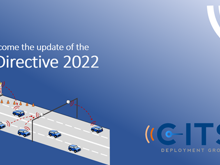Lives and Investments are Safeguarded by ITS G5 Seamless Evolution, CAR 2 CAR Communication Consortium
2019 Day 1 deployments started in Europe based on ETSI ITS G5. The cooperative V2X functions are expected to assist improving road safety towards accident free traffic (vision zero), enhancing road capacity, reducing harmful emission to the environment (green deal), supporting successive automation on roads and by that are enabler for further disruptive changes of mobility in future. Investing vehicle manufacturers and road operators see clear advantages in the seamless evolution principle of ITS G5. By using this technology, you have the freedom to reliably operate deployed safety related functions over time as it is designed to be future proof, supporting multi-generational operation between older and newer vehicles, road infrastructure and devices serving their different economic lifecycles. Thereby, today and in future IEEE-based V2X fosters innovations like cooperative automated driving and protection of vulnerable road users without sacrificing safety or undermining investments. Hence, the V2X ITS G5 technology and the standardised protocols give you the best preconditions for shaping future mobility.
Since the beginning of the V2X developments in 2002 the CAR 2 CAR Communication Consortium builds its roadmap for cooperative automated driving and accident free traffic on a foundation of innovation that preserves interoperability and backwards compatibility. All developed message sets, functions and technologies follow this basic principle. A prominent example at present is the standardisation of the new NGV (Next Generation V2X) radio at IEEE. The NGV standard (called IEEE 802.11bd) is being specified to be fully interoperable with current ITS G5 standard while flexibly offering powerful new features. The seamless evolution of the NGV radio enables efficient, best use of the allocated ITS spectrum, avoiding expensive redundant radio technologies or retransmissions of “translated” messages in parallel channels. The more powerful transmission features are automatically used when no older radio system is detected in the vicinity. Due to this migration feature cooperative functions based on Day 1 message sets like Cooperative Awareness Message (CAM) or Decentralised Environmental Notification Message (DENM) become more powerful over time as future vehicles deploy NGV radios instead of first generation ITS G5 radios.
This year the new Golf 8 has received the EURO NCAP Advanced reward for its Car2X Local Hazard Warning system equipped as standard. Due to the seamless evolution path even in 20 years when all cars are V2X-equippd, today’s Golf 8 cooperative functionality will continue to support the driver without any restrictions. Usually roadside equipment even has longer lifecycles. Cooperative Roadside Stations implemented at gantries or traffic lights might be operated for the next 30 years. During their complete lifetime they can provide their cooperative services even if at this future time road traffic might have developed to be based on fully cooperative automated driving vehicles which protect vulnerable road users and other road users by integrated cooperative safety measures.
The automotive C-ITS deployment is complemented by the C-Roads initiative having started in 2019 the first ITS G5 installations in the European road infrastructure. Due to its excellent features the ITS G5 technology and the standardised protocols ITS G5 is also considered for rail solutions to support rail specific operational and safety applications.
About the CAR 2 CAR Communication Consortium
Enhancing road safety and traffic efficiency at the earliest possible date by means of Cooperative Intelligent Transport Systems and Services (C-ITS) is the dedicated goal of the CAR 2 CAR Communication Consortium. The industrial driven, non-commercial association was founded in 2002 by vehicle manufacturers affiliated with the idea of cooperative road traffic based on Vehicle-to-Vehicle Communications (V2V) and supported by Vehicle-to-Infrastructure Communications (V2I). The C-ITS roadmap is formed by the initial deployment phase (Day 1) followed by further innovation phases towards cooperative automated driving and aiming on the vision zero. The Consortium comprises of major vehicle manufacturers, automotive suppliers, infrastructure suppliers, engineering companies and research organisations.
Over the years, the CAR 2 CAR Communication Consortium has evolved to be one of the key players in preparing the initial deployment of C-ITS in Europe in 2019 with associated partners in AUS, NZL, ISR and SGP and fostering the subsequent innovation phases. CAR 2 CAR members focus on wireless V2X communication applications based on ETSI ITS-G5 (ITS G5) and concentrate all efforts on creating standards to ensure the interoperability and seamless evolution of cooperative systems, spanning all vehicle classes across borders and brands. As a key contributor, the CAR 2 CAR Communication Consortium works in close cooperation with the European and international standardisation organisations such as ETSI and CEN.
Contact:
CAR 2 CAR Communication Consortium
Niels Peter Skov Andersen, General Manager
Phone: +45 4018 4793
Dr. Karl-Oskar Proskawetz, Administrator
Phone: +49 531 231721-10
E-mail: contact@car-2-car.org
Web: http://www.car-2-car.org
